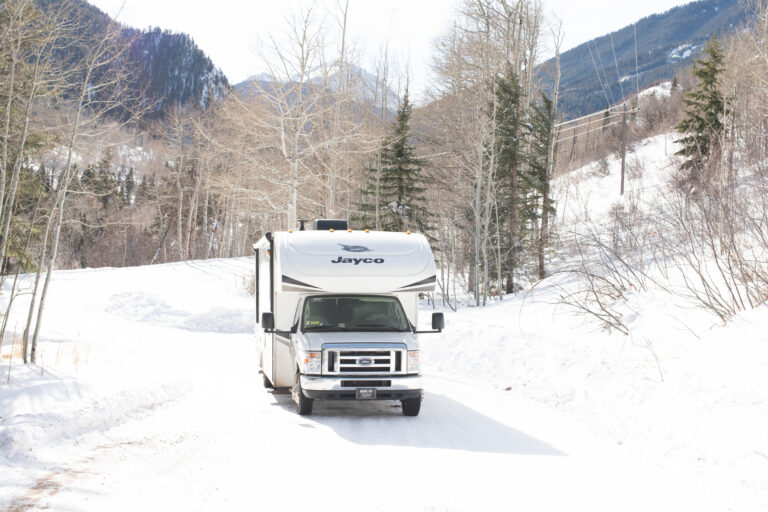
If you’re planning to drive your RV through a wintery landscape soon, you may be facing a level of fear — even if you took to RV driving like a pro in the first place. Icy roads and snow-covered shoulders add a whole new level of hazard to driving any vehicle, let alone one big enough to hold an entire house.
But if you follow a few best practices and make sure to prepare as much as possible, motoring your way through winter wonderland will be a piece of cake. (OK, maybe that’s overstating it a bit. But it won’t be so bad, and it will be crazy beautiful. And you’ll have access to all the gear to make fresh hot chocolate the moment you reach your destination!)
So before you set out into the frozen tundra, here’s what you need to know.
1. Your RV handles differently than your car.
This point might seem obvious.
But if you’re old hat at driving through the rain, sleet, frost, or snow, getting cocky could be dangerous. Handling an RV is a totally different animal.
Most motorhomes utilize rear-wheel drive, as opposed to the front-wheel drive common in most smaller passenger vehicles — which means that many of the tactics you’d use to divert a slippery situation in your car won’t work the same way in your rig.
Although the sheer weight of the RV might make it feel as if you’re steady on the ground, most of that mass is in the front wheels. And in a rear-wheel drive vehicle, that means you have less control and traction. Even if you’re towing, keep in mind that you’ve got a lot of weight behind you, and if you brake too late or too hard, that weight will push your vehicle around — to say nothing of the risk of jack-knifing, should the trailer skid.
So, what can you do? Go slowly, brake easily, and leave tons of room between you and the car ahead of you.
Additionally, double-check the manual of any automatic brakes or brake controllers you might have equipped to ensure they’re meant for operation in snowy conditions.
2. Check your tires.
Even if you routinely skip the snow tires on your day-to-day vehicle, you’ll want to spring for an upgrade in your RV. Most rigs come pre-equipped with highway tread or summer tires, which are quiet — but lack the gripping power you need to stay safe in the snow.
You’ll also want to pick up a set of tire chains in case conditions get seriously messy. In fact, some states require chains by law during adverse conditions, especially for trailers. Be sure you know the rules in your area before you hit the road.
3. Use your low beams.
Ever walk through a snowy landscape without sunglasses? Bet you didn’t make that mistake twice.
Bright lights reflect off snow, disrupting your vision. Use your low beams if necessary, and if possible, avoid night driving altogether. The snow itself is enough to deal with — you don’t need to add darkness to the mix!
4. Your RV’s pipes can freeze, too.
You take precautions to winterize your home, right?. You’ll need to winterize your RV, too. Otherwise, you may be facing a costly repair bill — and a huge inconvenience – when your rig’s pipes freeze halfway through your trip.
Although some RVs do have heated water duct systems, many do not, especially if yours is an older model. If you’re not sure, check with your local motorhome specialist to see what steps you need to take. Aside from wrapping pipes in heat tape, you can also find RV-specific antifreeze for potable water systems. Be sure not to use the regular automotive kind!
5. Check your batteries.
Cold weather decreases battery performance, and you don’t want to end up stalled out or without access to heat.
Ensure all your batteries — including auxiliaries — are well-charged and in good working condition before leaving. And just in case, make sure you’re well-stocked on propane, too: You may need to run your generator for heat.
6. Gear up.
Ensure you’ve got plenty of bottled water, extra food and lots of clothing. You’re better off safe than sorry if you should find yourself stuck.
Psst: Don’t forget your windshield ice scraper!
7. Don’t be afraid to change your plans.
Bottom line? If you’re feeling unsure or unsafe, stop.
Derailing your travel plans might be a bummer, but it’s a whole lot better than sliding off the road into an icy ditch, or worse.
Take advantage of the opportunity to gas up, and maybe even to explore a town that wasn’t originally on the docket. Your final destination will still be there when the weather clears up.
Stay safe out there!
